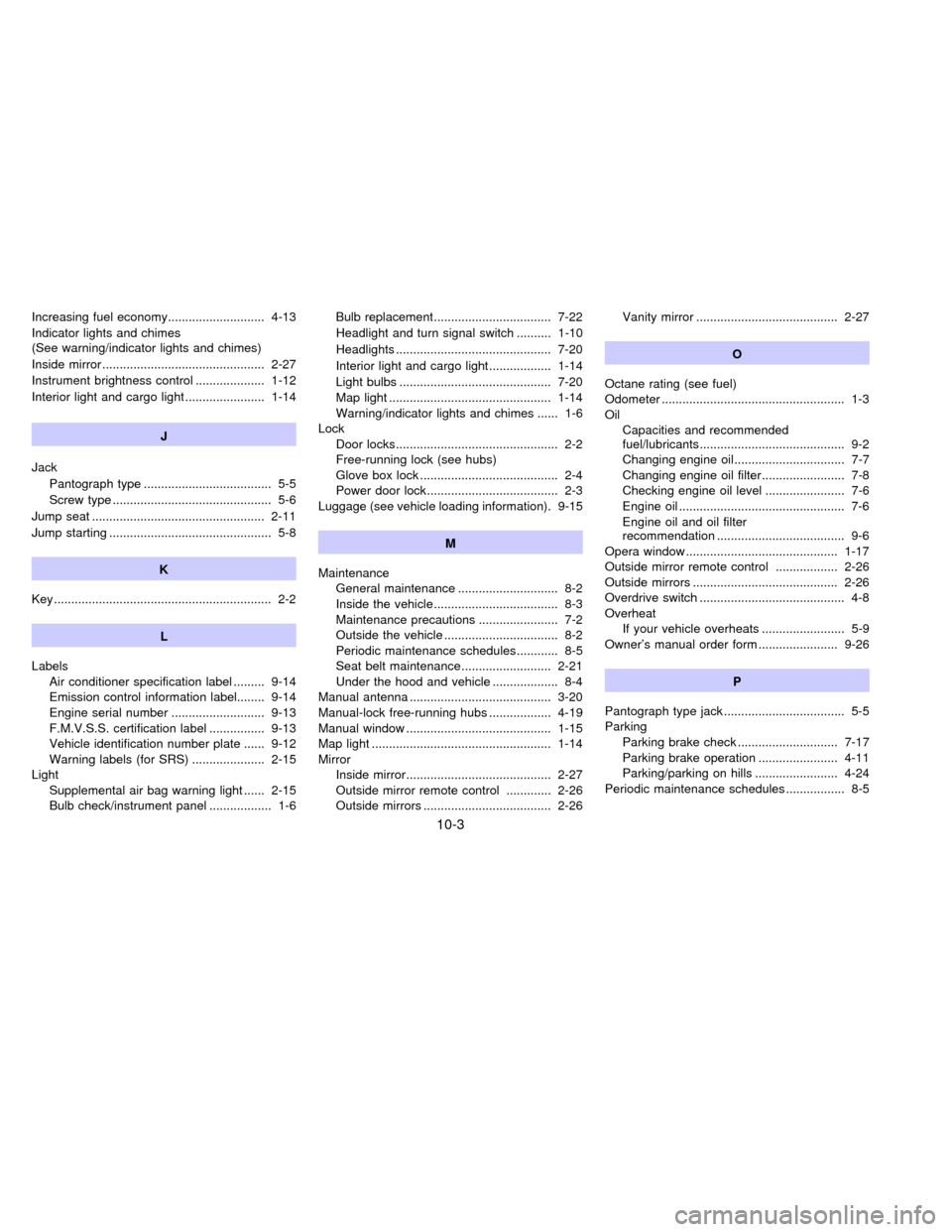1996 NISSAN FRONTIER engine overheat
[x] Cancel search: engine overheatPage 185 of 198

Trailer towing tips
In order to gain skill and an understanding
of the vehicle's behavior, you should prac-
tice turning, stopping and backing up in an
area which is free from traffic. Steering,
stability and braking performance will be
somewhat different than under normal driv-
ing conditions.
cAlways secure items in the trailer to
prevent load shift while driving.
c
Avoid abrupt starts, acceleration or stops.
cAvoid sharp turns or lane changes.
cAlways drive your vehicle at a moderate
speed.
cAlways block the wheels on both vehicle
and trailer when parking. Parking on a
slope is not recommended; however, if
you must do so, and if your vehicle is
equipped with automatic transmission,
first block the wheels and apply the park-
ing brake, and then move the transmis-
sion shift lever into the P position. If you
move the shift lever to the P position
before blocking the wheels and applying
the parking brake, transmission damage
could occur.cWhen going down a hill, shift into a lower
gear and use the engine braking effect.
When ascending a long grade, downshift
the transmission to a lower gear and
reduce speed to reduce chances of en-
gine overloading and/or overheating.
However, for long steep grades, do not
stay in 1st or 2nd gear when driving
above 35 MPH (56 km/h).
cIf the engine coolant rises to an ex-
tremely high temperature when the air
conditioning system is on, turn off the air
conditioner. Coolant heat can be addi-
tionally vented by opening the windows,
switching the fan control to high and
setting the temperature control to the
HOT position.
cTrailer towing requires more fuel than
normal circumstances.
cAvoid towing a trailer for your vehicle's
first 500 miles (800 km).
cHave your vehicle serviced more often
than at intervals specified in the recom-
mended Maintenance Schedule.
cWhen making a turn, your trailer wheels
will be closer to the inside of the turn than
your vehicle wheels. To compensate forthis, make a larger than normal turning
radius during the turn.
cCrosswinds and rough roads adversely
affect vehicle/trailer handling, possibly
causing vehicle sway. When being
passed by larger vehicles, be prepared
for possible changes in crosswinds that
could affect vehicle handling. If swaying
does occur, firmly grip the steering
wheel, steer straight ahead, and immedi-
ately (but gradually) reduce vehicle
speed. This combination helps to stabi-
lize the vehicle. Never increase speed.
cBe careful when passing other vehicles.
Passing while towing a trailer requires
considerably more distance than normal
passing. Remember the length of the
trailer must also pass the other vehicle
before you can safely change lanes.
cTo maintain engine braking efficiency
and electrical charging performance, do
not use fifth gear (manual transmission)
or overdrive (automatic transmission).
cAvoid holding the brake pedal down too
long or too frequently. This could cause
the brakes to overheat, resulting in re-
duced braking efficiency.
9-20
ZX
Page 194 of 198

Increasing fuel economy............................ 4-13
Indicator lights and chimes
(See warning/indicator lights and chimes)
Inside mirror ............................................... 2-27
Instrument brightness control .................... 1-12
Interior light and cargo light ....................... 1-14
J
Jack
Pantograph type ..................................... 5-5
Screw type .............................................. 5-6
Jump seat .................................................. 2-11
Jump starting ............................................... 5-8
K
Key ............................................................... 2-2
L
Labels
Air conditioner specification label ......... 9-14
Emission control information label........ 9-14
Engine serial number ........................... 9-13
F.M.V.S.S. certification label ................ 9-13
Vehicle identification number plate ...... 9-12
Warning labels (for SRS) ..................... 2-15
Light
Supplemental air bag warning light ...... 2-15
Bulb check/instrument panel .................. 1-6Bulb replacement.................................. 7-22
Headlight and turn signal switch .......... 1-10
Headlights ............................................. 7-20
Interior light and cargo light .................. 1-14
Light bulbs ............................................ 7-20
Map light ............................................... 1-14
Warning/indicator lights and chimes ...... 1-6
Lock
Door locks............................................... 2-2
Free-running lock (see hubs)
Glove box lock ........................................ 2-4
Power door lock...................................... 2-3
Luggage (see vehicle loading information). 9-15
M
Maintenance
General maintenance ............................. 8-2
Inside the vehicle.................................... 8-3
Maintenance precautions ....................... 7-2
Outside the vehicle ................................. 8-2
Periodic maintenance schedules ............ 8-5
Seat belt maintenance.......................... 2-21
Under the hood and vehicle ................... 8-4
Manual antenna ......................................... 3-20
Manual-lock free-running hubs .................. 4-19
Manual window .......................................... 1-15
Map light .................................................... 1-14
Mirror
Inside mirror.......................................... 2-27
Outside mirror remote control ............. 2-26
Outside mirrors ..................................... 2-26Vanity mirror ......................................... 2-27
O
Octane rating (see fuel)
Odometer ..................................................... 1-3
Oil
Capacities and recommended
fuel/lubricants.......................................... 9-2
Changing engine oil................................ 7-7
Changing engine oil filter........................ 7-8
Checking engine oil level ....................... 7-6
Engine oil ................................................ 7-6
Engine oil and oil filter
recommendation ..................................... 9-6
Opera window ............................................ 1-17
Outside mirror remote control .................. 2-26
Outside mirrors .......................................... 2-26
Overdrive switch .......................................... 4-8
Overheat
If your vehicle overheats ........................ 5-9
Owner's manual order form ....................... 9-26
P
Pantograph type jack ................................... 5-5
Parking
Parking brake check ............................. 7-17
Parking brake operation ....................... 4-11
Parking/parking on hills ........................ 4-24
Periodic maintenance schedules ................. 8-5
10-3
ZX
Page 197 of 198

Recommended fuel:
Unleaded gasoline, at least 87 AKI number
(RON 91)
For further details such as gasohol or diesel
fuel grade, see ``Fuel recommendation'' in
the ``Technical and consumer information''
section.
Recommended engine oil:
Energy Conserving Oils of API SG or SH,
SAE 5W-30 is preferable for all tempera-
tures. See ``Engine oil and oil filter recom-
mendation'' in the ``Technical and consumer
information'' section.
Tire cold pressure:
See the tire placard affixed to the glove box.
Recommended new vehicle
break-in procedure:
During the first 1,000 miles (1,600 km) of
vehicle use, follow the recommendations
outlined in the ``BREAK-IN SCHEDULE''
found in the ``Starting and Driving'' section
of this Owner's Manual. Follow these rec-
ommendations for the future reliability and
economy of your new vehicle. Failure tofollow these recommendations may result in
vehicle damage or shortened engine life.(page)
cIn case of emergency ...................... 5-1
(Flat tire, engine will not start, overheat-
ing, towing)
cHow to start the engine ................... 4-1
cHow to read the meters and
gauges ............................................. 1-1
cMaintenance schedule ..................... 8-1
cDo-it-yourself operations.................. 7-1
cTechnical and consumer
information ....................................... 9-1
GAS STATION INFORMATION QUICK REFERENCE
10-7
ZX